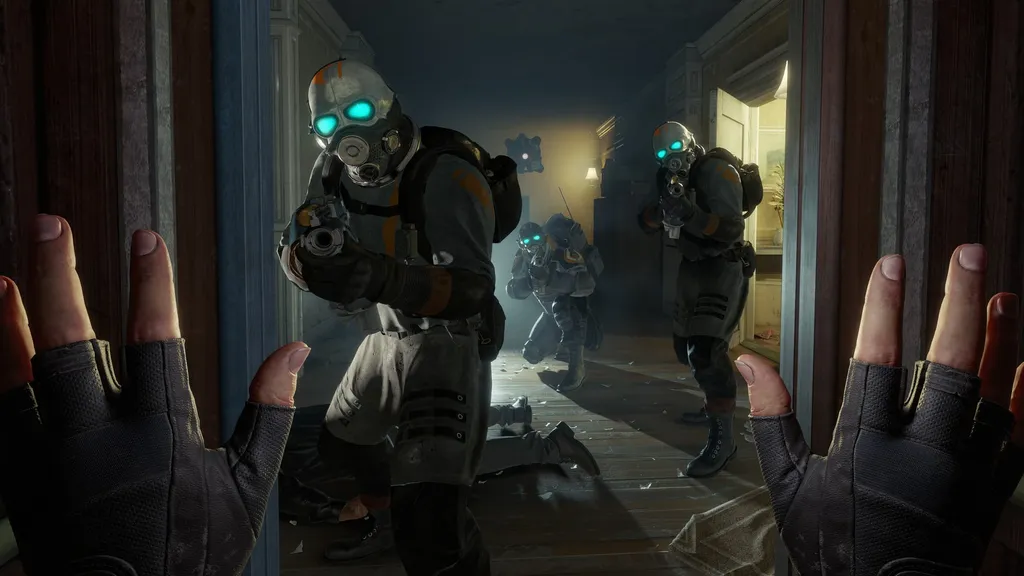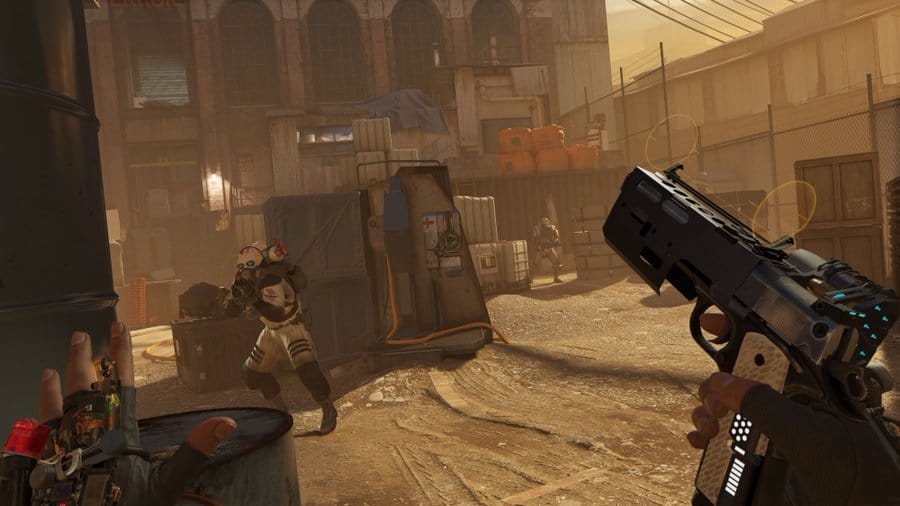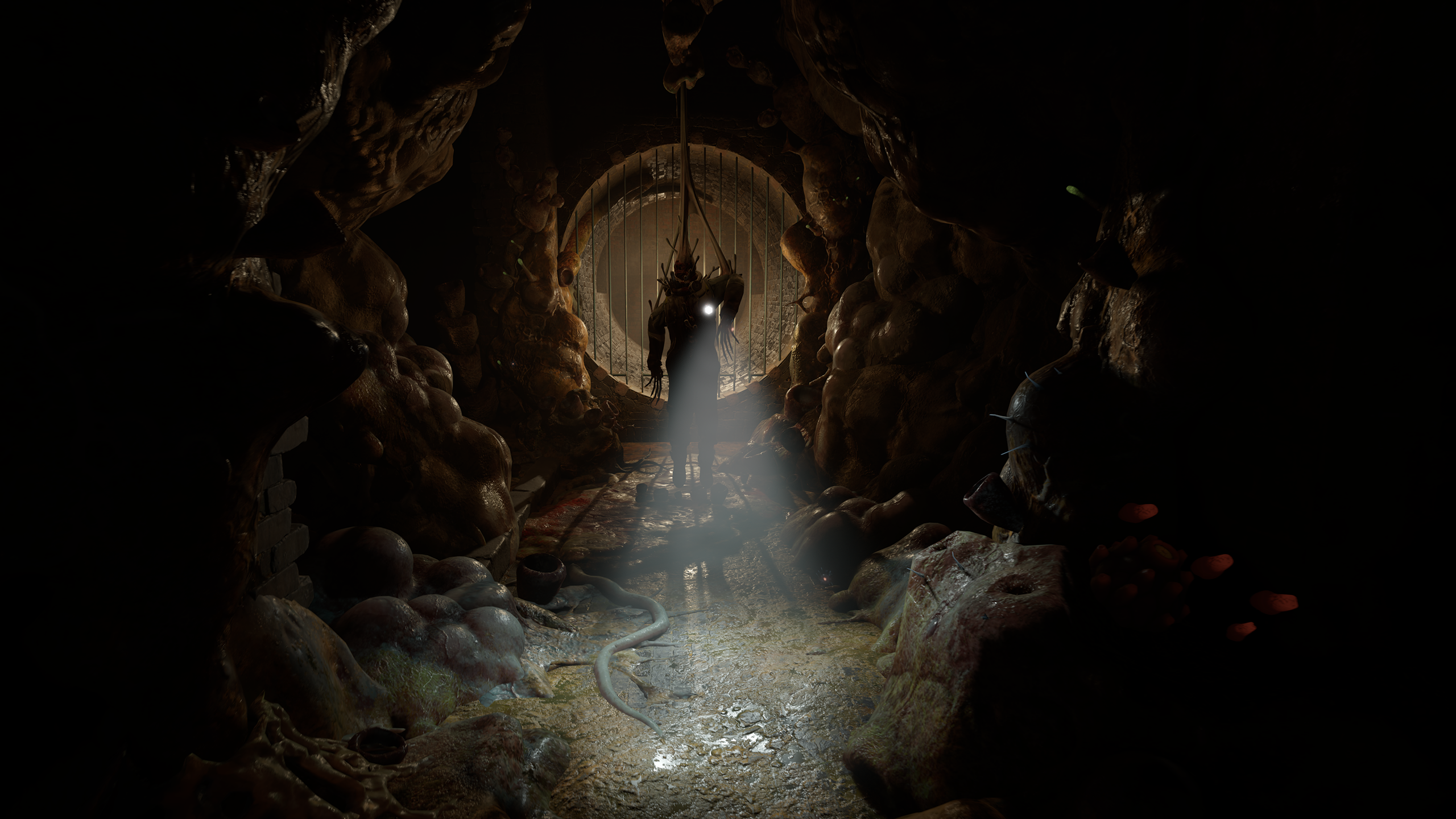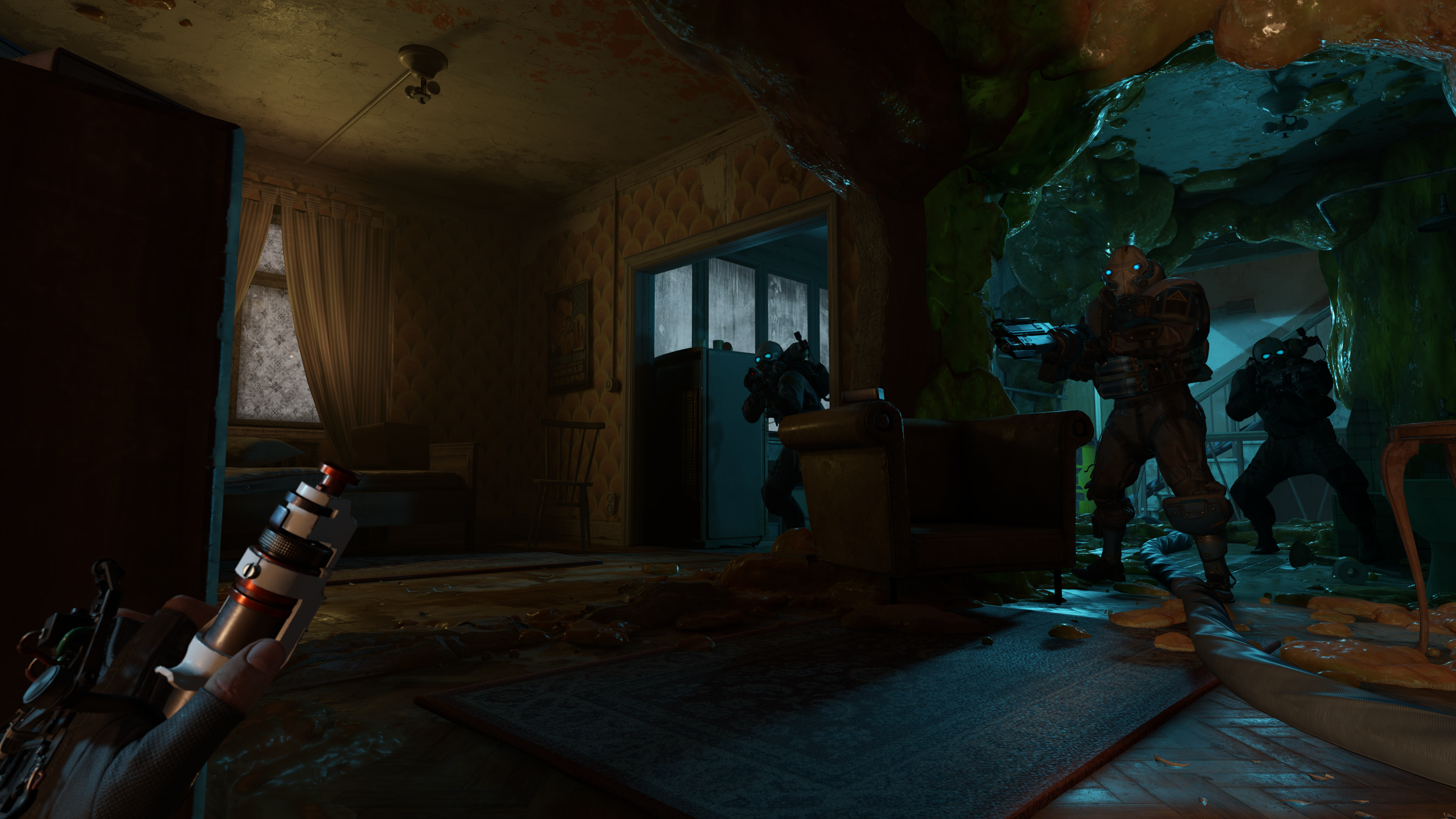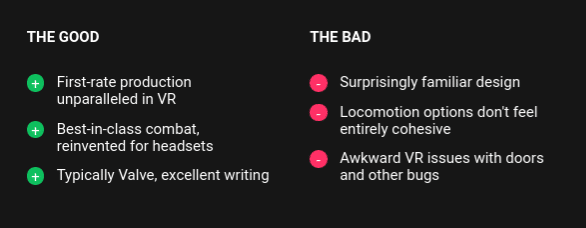Second chances. Not everyone gets one. And yet, in Half-Life: Alyx, Valve finds itself with an embarrassment of them.
Forget all that ‘back from the dead’ stuff for a minute; you don’t need me to tell you Half-Life has been away for a very long time. More pressing is the make-or-break moment Alyx represents for VR, a potential do-over for a platform that, let’s face it, still has a lot of people to win over. Second chances like that don’t come around often. Rest assured, Valve doesn’t take that responsibility lightly.
Return To City 17
Half-Life’s big return is, for starters, unparalleled in production. Alyx has a world so lavish in apocalyptic dressing and setpieces so thoughtfully sequenced you’d be forgiven for mistaking the game for a flagship PlayStation or Xbox exclusive. And yet, for better or worse, Alyx is also a game of surprising familiarity, not just in the DNA it’s dusted off after these many years but in how it approaches the platform. For a long-time VR player, Alyx doesn’t hold a lot of ‘new’, and it doesn’t have many answers to the medium’s more persistent issues. But what it does right, it almost always does the best.
The decision to double back to a time before Half-Life 2 and cast you not as the crowbar-wielding Gordon Freeman but instead the pistol-slinging Alyx Vance is a wise one, freeing Valve up from at least some of the crushing pressure that putting a ‘3’ in that title would apply. And, conveniently, it pits Alyx at a crucial and unexplored time in the Half-Life canon, with the human race still licking its wounds as it adapts to life under the rule of Combine stormtroopers.
More importantly, though, it’s a great way for the franchise to find its feet again, especially in uncharted territory. Much of Alyx is spent both re-familiarizing yourself with the world of Half-Life and re-examining what its staple elements mean in VR. It’s a game of physics and, now more than ever, the physical; Combine encounters, for example, evolve from their run-n’-gun roots to heftier, more tangible slowburn shootouts in which the world is both a weapon and a shield.
Combine Combat
If you’re prepared to pantomime, Alyx holds some of the most active and immersive combat you can experience in VR. In its tougher battles I’d find myself huddled on the floor, opening car doors to fire through the gaps in driver seats, instinctively flinching at the hammer of gunfire above and then poking out remaining shards in a shattered window to access a stray ammo clip with the flick of my Gravity Gloves before fumbling a hasty reload.
Oh, and those gloves — more appropriately nicknamed ‘the Russells’ after their inventor — are a wonderful thing, effortlessly intuitive and moreish to use by executing a simple flick of the wrist to summon an object to your hand with a well-timed catch. Alongside streamlining scavenging without sacrificing it, they’re a big part of what gives Alyx’s action flow, a mechanically dependable linchpin in the middle of the juggling act firefights often prove to be.
[vc_row][vc_column][vc_cta h2=””]Comfort
Comfort is a big concern for Valve, and it shows. Alyx is littered with different options to accommodate as many people as possible. You can choose between a traditional “Blink” teleport, a “Shift” where the camera dashes to the next point, or “Continuous” aka smooth locomotion directed either by your head or hand. Each of these options can be further tuned to your preferences. The game even has a one-handed option mode. Whatever comfort or space concerns you have, chances are Half-Life: Alyx has an option for you.
[/vc_cta][/vc_column][/vc_row][vc_row][vc_column][vc_column_text]
Alyx is also more directly interested in puzzles than previous games, keen to utilize VR to the fullest extent. Your Multi-Tool is in constant use to unlock doors and ammo crates by beating holographic challenges. They’re hit and miss, with some of the more menial challenges getting tiresome — like guiding a beacon on a holographic sphere past a maze of mines. But when they hit they’re absolutely fantastic, like the act of following wires inside the walls to reconnect electricity which might require you to push items out of the way or create makeshift platforms to find the right path forward. It’s a brilliant application of VR.
What the game loses in its transition to VR — namely intuitive movement and weapon variety (there’s only three guns) — it makes up for in the versatility of full human control. But there’s a smoothness to it, a certain amount of hassle-free fluidity that games like say, Boneworks, don’t quite match, that gives it a sharper edge. It might not be Half-Life in feel, at least not straight away, but it’s unmistakably Half-Life in approach.
Half-Life Goes Horror
Nowhere is that more true than in the encounters with Xen aliens, which are given vicious new life. They’re no longer solved with a waggle of a crowbar but fought tooth and nail in a battle of proximity and rushed reloads, often channeling the pressured intensity of a game like Resident Evil 4. Not just in the plate spinning act of keeping zombies and headcrabs at bay but in the unavoidably anxious and utterly human desire to want to be as far away from them as possible.
In fact, you might even label Alyx as a horror game and, as unnerving as that may sound, it’s one of the game’s most natural transitions. How could it not be? Jumping, fleshy (and sometimes disturbingly hairy) face-suckers spring at you in the cruel knowledge that your brain will trigger momentary panic, and wailing, whimpering zombies swagger and stumble out from the shadows, no longer marching forward, giggling like a Beavis and Butthead cartoon.
What makes Alyx’s brand of terror work so well, though, is in how manageable it is. Valve is rightly responsible with its arsenal of gruesome minions, at least at first. The game is sensible in its scares; very rarely so mercilessly nightmarish as to overwhelm you, but also unpredictable enough to keep you on your toes. Only a couple times in the game are headcrabs hidden behind corners or sneaking through vents, appearing at the flick of a flashlight. Instead they’ll make themselves known to you, swinging out from behind pipes or leaping down from ceilings a good few meters away to help lull you into a necessary security, however slight.
It’s a masterclass in VR horror; not so much teaching how to make it as how to deal with it. By the time Valve trusts you with some of its more heart-rending moments — including one spectacularly mean-spirited puzzle twist — you’ve taught yourself to toughen up. It’s a remarkable bit of player conditioning, an achievement in working with you to push and help conquer that which you might not have thought you’d be able to face.
Old Headcrab, New Tricks?
This is very much a case of teaching an old dog new tricks, then. If, as a long time Half-Life fan, these changes sound startling and unruly, consider that, to long time VR fans, they instead sound surprisingly familiar. And that’s because Alyx is a shockingly recognizable experience to the initiated.
Much of what I’ve described above, the physicality of combat or the realness of the horror, has already been seen in VR before. Think Superhot VR’s handful of expertly-crafted combat sequences, or Budget Cuts’ striking spontaneity, and you’ll get a reasonable idea of what to expect here. You might go into Alyx ready for Valve to turn all of that on its head, but the truth is it doesn’t. Instead, Alyx feels far more concerned with bookending the last four years of the VR industry, surgically dissecting its strongest elements and then applying them to a campaign of over ten hours in length.
[vc_row][vc_column][vc_cta h2=””]Rift S vs. Index Controllers
Though Half-Life: Alyx can be played with basically any PC VR headset, it’s been designed first and foremost with Valve’s own Index device. Index’s premium spec sheet undoubtedly makes it the best way to play Alyx, but the gap between playing on that and the Oculus Rift S isn’t too big. In fact, Index’s ‘exclusive’ gameplay features, made possible by controller finger tracking, are very, very insubstantial. You can squeeze the controller to activate grenades and crush cans and, of course, you can flip off the Combine. That’s about it. If you can play it on Index then absolutely go that route, but you won’t be missing too much going without the Index controllers.
[/vc_cta][/vc_column][/vc_row][vc_row][vc_column][vc_column_text]
Undoubtedly, it is every bit the polished campaign you’re hoping for, but Alyx rarely feels as revelatory as you might expect. It can, at times, echo the spark of constant reinvention the series is known for but it’s less concerned with charting new mechanical territory for VR as it is just giving you, well, something that’s damn good to play. I suppose, in a way, that polish, scale and thoughtfulness is its contribution, and it’s a valuable one for sure. It’s just not the one I was quite expecting.
It steers well clear of the muddy waters of melee combat, for example, which games as recent as The Walking Dead: Saints & Sinners established a pretty good grasp on, and you can’t turn everything into a weapon like you could in Boneworks. The puzzling thing is that there is that potential of physics wizardry in the game, it just never really necessitates it.
First and foremost this is a gun game for more than it is a physics playground like Boneworks. You can and scoop a headcrab up in mid-air and stuff it into a barrel or toss it out of a window. But if you do, or you try anything beyond that, there’s a chance things might go a little janky. And besides, you always have a pistol with enough ammo to kill it instead — so why bother? Valve misses an opportunity not to capitalize on these more groundbreaking elements in the way its contemporaries have.
With Alyx, there’s a sense of getting the basics down before Valve might move on to more ambitious concepts (something the game hints might happen). Though that’s a four-year task in itself, it’s disappointing – and somewhat surprising — that Alyx doesn’t plant a flag in many truly new areas.
New Friends And Old Haunts
There are flags to be planted elsewhere, though. If Half-Life 2 made City 17 an iconic setting, Alyx makes it a more convincing reality. Alyx and her companion-over-comms Russell’s search to save her captured father quickly escalates into a race to find a mysterious Combine item of interest that has her making a beeline through the city. What begins as a familiar trek across rubbled train stations and hushed streets soon reveals a side to City 17 yet unseen.
Within an abandoned vodka distillery lurks a horrific monster that can be lured by breaking the scores of bottles that surround him. A zoo is turned into a headcrab pen, with cages of critters daring you to open them in a mad scramble for spare ammo. These sections, and others, offer up high concept scenarios that, until now, have been practically alien to VR and, importantly, start to pile on thick and fast once the game is through its lengthy — if very necessary — onboarding hours.
Different, too, is the tone, which carries an abnormal and welcome strain of optimism. Alyx and Russell longingly daydream of ‘when’ the Combine are defeated to pass the time. “The Combine aren’t going to be around forever,” Russell states early on. Their misplaced resolve shows a side to Half-Life we haven’t seen before.
Recognising what a disservice it would be to bottle Alyx’s warming personality up in the silent protagonist role, she’s free to quip “Bye zombie” as she quietly lets grenades slip through her fingers and onto the heads of unsuspecting enemies below. Though it’s a shame not to see Merle Dandridge returning to voice Alyx, Ozioma Akagha fills her shoes with the perfect amount of pep and unbeatable enthusiasm. Flight of The Conchord’s Rhys Darby, though, injects Russell with the compelling blend of naive curiosity and distracted humor his sharp script requires. Adding Firewatch developer Campo Santo to Valve’s team seems to have paid off.
Write On Point
In fact it should be little surprise in a post-Portal 2 world that the writing in Alyx is pitch-perfect, deftly balancing absurdist and genuinely hilarious humor with moments of concentrated power and connection. And VR proves a potent ingredient in forming that bond.
Early on in the game, you’re hesitantly making your way through a pitch black environment, aided only by a flashlight. Shaken, Alyx asks Russell to recall pre-Combine Earth. He instead waxes about the miracle of the club sandwich. I catch myself laughing, first at his ridiculously exhaustive monologue, which spares no detail, and then because I realise that, heaven help me, it’s working on me. I — a self-confessed VR coward — am no longer quivering at the thought of edging forward; I’m thinking about that grandiose monument to human decadence, just like Alyx. It’s a moment of full surrender to the VR spell in a way that I have simply never experienced.
Reality Bites
And yet that spell can also be broken quite easily. If there’s one thing Alyx isn’t, it’s the remedy to some of VR’s most troublesome intricacies. The game’s plethora of movement options, for example, cater to both the comfortable and the more immersive, but neither focus is entirely cohesive with the world around you.
Smooth movement often slips and slides over bumps in the game’s geometry and proves too tempting an alternative to properly utilizing cover in combat. I started with that option but, about halfway through, switched to Shift. Most of the game feels built around this option but still struggles with aspects like opening doors. It’s a process that never feels quite right (in fact, you spend so much time fighting them you might consider them an enemy). Plus some of the more explosive setpieces, including a late-game chase sequence, are at odds with this style of movement. These are troubles many VR games share but feel more damning under the light of Alyx’s expanded appeal.
At other points, it’s more of an own goal. Early on the game is teaching you how to jump, with a small gap to navigate. It’s not immediately clear what to do, but I remember a ladder just around the corner that could make short work of the obstacle. Much to my surprise, I can’t pick it up and hoist it over the gap as I would in Boneworks. It’s a jarring moment, to be sold this much on a reality this dense only to discover a gap in its rules that early on.
When the rules don’t bend, though, Alyx is a technical showcase to marvel at. Its environments, staggering in clarity, are quite literally littered with ‘stuff’, be it the rotten apples and half-squished toothpaste tubes resting in lockers, hiding upgrade points known as resin beneath them, or the scattered hard hats and debris quickly summoned to hand and then just as easily tossed onto an unsuspecting barnacle tongue to clear the way.
Half-Life: Alyx Review Final Impressions
The difficulty of Half-Life: Alyx is that all eyes are on it, not just as a game but as a justification of VR. And, though it shoulders that burden sincerely, Alyx’s jitters — no different from those found in its contemporaries — and adherence to established VR standards likely won’t persuade the platform’s biggest pessimists.
But, for the already-initiated and those susceptible to it, Alyx is a triumphant return; a stunningly produced, meticulously refined capping off of the past four years of VR learnings. Its 10+ hours of best-in-class combat, evolving level design and, every so often, moments of truly inventive ideas swiftly establishes it as a new benchmark for the platform.
And yet, Alyx leaves you with the lingering suspicion that there is yet more ground to cover, that there’s far more this series and this developer can do with this new set of tools and that this is only the first part of that story. Though you’ll find yourself hungry for more, there’s something comforting in the knowledge that, for Valve, this is the dawn of a new era. Half-Life: Alyx makes good on its second chance, it is as essential a VR game as you’ll find in 2020, but perhaps the most exciting thing about it is the message is that the best is yet to come.
Final Score: 



 5/5 Stars | Fantastic
5/5 Stars | Fantastic
Half-Life: Alyx is available now on SteamVR for PC VR headsets for $59.99. To find out more about how we arrived at this score, make sure to read our review guidelines.

